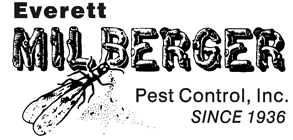Milberger Pest Control has a long history of successfully treating and protecting homes from destructive termites – insects that cost American consumers nearly $5 billion annually in treatments and repairs.
When most consumers think of termites, it’s the subterranean species. But did you know there’s a termite that doesn’t like to get its antennae dirty?
The drywood termite – unlike its soil-dwelling cousin – prefers to live above ground in wood siding, roofing, and wood supports inside structures. Drywood termites will swarm by the hundreds around the exterior of a home in search of an access point to make entry.
Fall is prime drywood termite swarming season, and swarms occur most often on sunny days after a spike in the mercury follows cooler temperatures.
What parts of your Blue Springs or Lee’s Summit home are at the greatest risk from drywood termites? Milberger Pest Control has noticed the following areas to be the most vulnerable to drywood termite infestation:
- Wood molding and framing around windows and doors
- Eaves and overhangs
- Protected joints or crevices in and around doors
- Attics and above-ground crawlspaces
- Wood siding and roofing – especially overhangs where shingles, paper under-sheeting, and wood meet
Drywood termites will excavate a small tunnel into the wood and then close it behind them, creating a chamber they will inhabit for a year or more. They can stay dormant for extended periods of time – more than a year – before re-emerging to resume their destructive activities.
Drywood termites are also creatures of habit, and have been known to re-infest the exact same place. This is why it’s important to have your home inspected regularly by a trained pest management professional who can identify the presence of drywood termites.
Here are some signs that drywood termites may be targeting your home:
- Large numbers of flying insects on the exterior (and sometimes on the interior) of your home
- Shed wings on windowsills
- Hollow-sounding or visibly damaged wood that is honeycombed or carved out. If you can make a hole easily in the wood with a pocket knife or flat-blade screwdriver, you may be looking at termite damage
- Unexplained piles of what look like coarse grains of sand (actually, termite fecal pellets pushed out by the termites)
Remember: If you suspect your home has a problem with drywood termites, call in MO – (816) 761-1313 or KS – (913) 384-6760, or drop me an email at: info@milbergerpestcontrol.com. Our highly trained, fully licensed termite professionals will inspect your home thoroughly. If treatment is required, they will recommend preventative and curative treatments that are backed by our guarantee of 100-percent satisfaction.
